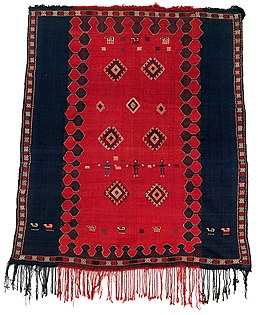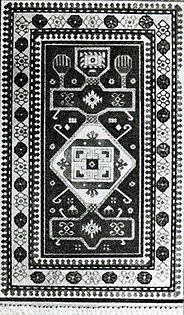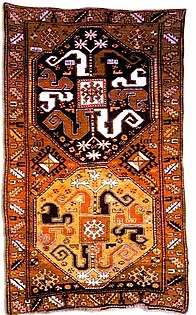Azerbaijani rug
Azerbaijani rugs (Azerbaijani: Azərbaycan xalçaları) are traditional rugs made in the geographical area of Azerbaijan. The Azerbaijani rug is a handmade textile of various sizes, with a dense texture and a pile or pile-less surface, whose patterns are characteristic of Azerbaijan's many carpet-making regions. Traditionally, the carpets were used in Azerbaijan to cover floors, decorate interior walls, sofas, chairs, beds and tables.[1]
Carpet making is a family tradition transferred orally and through practice, with carpet making and rug making being solely a women's occupation. In the past, every young girl had to learn the art of weaving carpets, and the carpets she wove became a part of her dowry. In the case of a newly married son, it was his mother who wove a large rug for his new household. Traditionally, men sheared the sheep in the spring and autumn, while women collected dyestuffs and spun and dyed the yarn in the spring, summer and autumn.[1]
In November 2010 the Azerbaijani carpet was proclaimed a Masterpiece of Intangible Heritage by UNESCO.[1]


Gallery[]

A 19th century Azeri shadda. exhibited at the Textile Museum (Washington, D.C.)

Silk embroidery, 17th–18th century. In the collections of the Textile Museum (Washington, D.C.)

Namazlyg carpet from Shusha. 19th century.

Bakhshayish carpet. 19th century.

An Azerbaijani carpet from the Shirvan group from Bijo village, mid-19th century

A Karabagh carpet of the Malibayli sub-group. Malibayli village of Shusha, 1813
Carpets in social and economic life[]

In Azerbaijan, carpets are used to decorate the home and to carry a cultural significance as a family tradition transferred verbally and with practicing, and are associated with the daily lives and customs of Azerbaijani people. Azerbaijani folk-art, particularly carpet weaving, has been the subject of attention from the government to preserve, study, promote and develop carpet weaving traditions of Azerbaijani people.[2][3] A law called “On the Protection and Development of Carpet Art of Azerbaijan" was adopted in December 2004,[4] "" was established in May 2016,[5] started to be celebrated on May 5th according to a presidential decree.[6] A new building for Azerbaijan Carpet Museum, which was designed by Austrian architect in the shape of a rolled carpet, was constructed between 2007 and 2014.[7] In addition, a state program on the “Protection and development of carpet art in the Republic of Azerbaijan 2018–2022” was approved in February 2018 by President Ilham Aliyev with the aim of creating raw material supply for this industry, improving the infrastructure for carpet-weaving, support the establishment of new workplaces, carry out qualified personnel training in the field of carpet-weaving, wool processing, wool and silk yarns manufacturing, and processing plants used for dyeing and production of dyes.[3]
See also[]
- Azerbaijani Carpet Weaving
- Azerbaijan Carpet Museum
- Latif Karimov
References[]
- ^ a b c "UNESCO - Traditional art of Azerbaijani carpet weaving in the Republic of Azerbaijan". ich.unesco.org. Retrieved 2021-04-16.
- ^ "UNESCO – Traditional art of Azerbaijani carpet weaving in the Republic of Azerbaijan". ich.unesco.org. Retrieved 2019-09-18.
- ^ a b "On the approval of the State Program for the "Protection and development of carpet art in the Republic of Azerbaijan 2018–2022"". Ministry of Justice of Azerbaijan – Database of Regulatory Legal Acts. Retrieved 2019-09-18.
- ^ "Law "On the protection and development of carpet art of Azerbaijan"". Ministry of Justice of Azerbaijan – Database of Regulatory Legal Acts. Retrieved 2019-09-18.
- ^ "About Azerkhalcha". azerxalca.az. Retrieved 2019-09-18.
- ^ "Azerbaijan celebrates Carpet Weaver Day | Vestnik Kavkaza". vestnikkavkaza.net. Retrieved 2019-09-18.
- ^ "Azerbaijan National Carpet Museum". azcarpetmuseum.az. Retrieved 2019-09-18.
External links[]
| Wikimedia Commons has media related to Rugs and carpets of Azerbaijan. |
- National Carpet Museum during the Soviet Era
- History of Azerbaijani Carpets/Rugs Archived 2016-03-04 at the Wayback Machine
- Azerbaijani culture
- Azerbaijani rugs and carpets
- Masterpieces of the Oral and Intangible Heritage of Humanity
- Turkic rugs and carpets
- National symbols of Azerbaijan
- Oriental rugs and carpets






